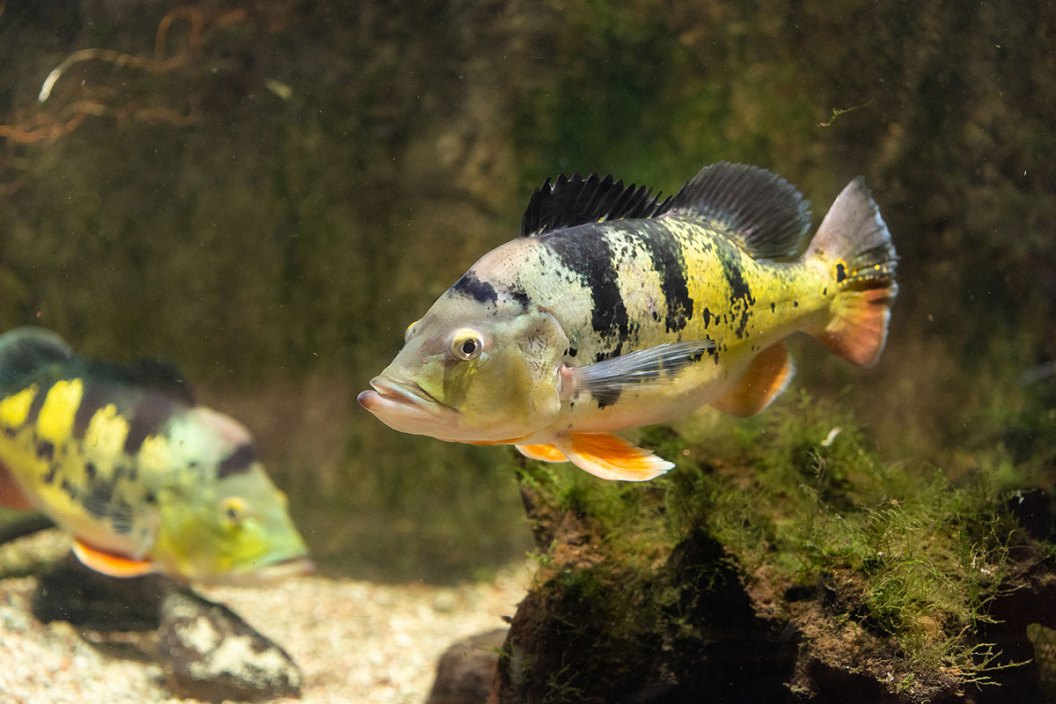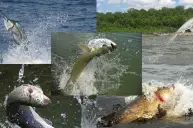The peacock bass is here to stay. Here's where they come from and why they are so much fun to catch.
Peacock bass are an Amazonian fish that have been brought to the United States for sport fishing reasons. Good reasons, that is, because they're so exciting to catch.
While there are 15 different peacock bass species, the butterfly peacock bass is the most prevalent in Florida, where they were introduced between 1984 and 1987.
The Florida Fish and Wildlife Conservation Commission (FWC) researched extensively before bringing these exotic fish into the Sunshine State. The objective was to both combat invasive species such as the African Spotted Tilapia, and provide excellent sportfishing opportunities for Florida anglers.
And provide that they have.
Other than their resoundingly different color patterns, the peacock bass and the revered largemouth bass are similar in size and shape while residing in many identical areas. Maybe the best thing about the Tucunaré (the Brazilian name for the species) is that they can be caught on much the same fishing tackle as the native largemouth. Even though they share these similarities, they are not closely related biologically. The peacock bass is actually a cichlid that is native to the Amazon and the Orinoco basins in South America.
To zoom in on the kind that has been introduced on our shores, here's a primer on the peacock bass, a sport fish accessible to more fishermen and women than you'd think.
The Peacock Bass
You can really narrow down peacock bass territory in Florida by automatically counting out saltwater. Since the peacock bass has a very low tolerance for saltwater, it is essentially considered a freshwater fish. According to the FWC, they were introduced "in large coastal canals of southeast Florida in 1984; low water temperatures and intolerance of saltwater prevent this species from becoming abundant outside of coastal Miami-Dade and Broward counties."
The peacock bass is the most successful in warmer, slow flowing canals, lakes, lateral canals, and quarry pits. They can be found in ambush areas which include shade found around bridges, culverts, and especially fallen trees.
These fish spawn all summer long with a peak around May and June. Once hatched, the young fry are guarded by both the male and the female for several months before moving on. It is suggested that the Florida peacock bass can live for about six years and attain approximately about the same size features as the largemouth bass, as an 18-inch fish will be around three pounds in weight.
The difference is that the IGFA world record is a fish caught in Venezuela that weighed in at 12.6 pounds. They don't exactly grow that big in America!
Maybe the best thing about this bass is that it is a voracious and extremely aggressive predator. Peacock bass eat primarily other fish species, but are especially valuable at keeping the invasive spotted tilapia in check.
However, one thing that you will almost never catch a peacock bass on is a plastic worm, but they absolutely destroy minnow imitating crank and jerk baits.
Peacock Bass Fishing
There are many good places to target these aggressive fish with some of the best being in and around Naples, Fort Lauderdale, West Palm Beach, and Miami. Another great thing about this fish is that they usually hunt during the heat of the day when there's a lot of light, chasing and destroying baitfish long after most anglers have had a chance to eat breakfast.
Peacock bass fishing in these areas can be done by boat, but many times more preferably by kayak and especially on foot. Since the Tucunaré lives and hunts in the same basic haunts as the venerable largemouth, you may even find yourself catching both.
Canal systems and even small lakes hold these "freshwater bullies" which are even known to have a devastating effect on fishing gear. Still, the same gear used for largemouths is usually the order of the day, along with a standard Florida fishing license.
Spinning gear in light to medium-light action is the most common with reels to match the circumstances. Aim for a reel that can hold plenty of 12-15 pound mono or a similar size of braid.
If you're just looking to catch them, live shiners are a must-have bait as any peacocks in the area can barely resist them. After that, anglers that love to cast for largemouths will appreciate knowing that topwater plugs, crankbaits, spoons, and stickbaits work equally well.
It's a great gamefish to practice a technique, as they're usually cooperative and eager to eat! Hang on tightly; peacock bass have been known to put a hurting on bait and the gear that you use!
Peacock Bass as a Popular Targeted Game Fish
Just for the record, Florida also holds a similar species called the speckled peacock bass. These were also introduced for the same reason, but it is illegal to possess or kill one due to their low numbers in the state.
There's no denying South Florida as a pinnacle of the American fishing industry. Such a wide range of people travel to have the access to fabulous fishing opportunities, and this special species should rank among some of the best.
Peacock bass are considered good eating, but most anglers practice catch and release for conservation purposes. However you go about enjoying them, just make sure you stay within the guidelines the FWC has laid out.
As a gamefish, the peacock bass is one of the toughest fighters that freshwater fisheries in the U.S. can offer up. They're great for anglers of all ages and abilities, and can produce a day of action when a lot of other species don't seem to want to play ball.
Peacock bass don't have the harsh effect on native species like other introduced animals have had in the past, and should be respected for their destruction of more harmful invasives such as the tilapia and the Oscar fish.
Peacock bass are also found in Texas in much smaller numbers and have recently been found in Arizona, but for an angling experience that's already established itself, Florida is the place to go.
What do you think? Ready to gear up and head south for some Peacock bass fishing?
Looking for a little more or even hot lunch for your hunting blind? Follow my webpage, or on Facebook and YouTube.
NEXT: 7 MOST EXTREME PLACES TO FISH IN THE WORLD





